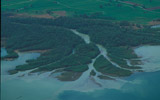Germany
Landscape, Climate and Water Flow
From its source, the Danube flows 584 km to the Austrian border. Interestingly, the Danube loses about half its discharge to the Rhine Basin through underground passages in its upper course near Immendingen. The largest tributaries to the Danube in Germany are the Naab, Isar, Lech, Inn and Salzach Rivers. The German Danube region includes the Swabian and Frankonian Alb, parts of the Oberpfälzer and the Bavarian and Bohemian Forests in the north. To the south lie the Swabian-Bavarian-Austrian foothills. The southern borderline is formed by the Alpine Rhine and Lake Constance as well as the southern tributaries of the Lech, Inn and Salzach Rivers.
The German Danube region is influenced by the Atlantic Climate with an average precipitation of about 1030 mm per year, increasing from north to south. The average monthly temperature is at its minimum in January (Danube Valley –1°C, Bavarian Forest –2°C, Alps –10°C) and reaches its maximum temperature in July (Danube Valley 20°C, Bavarian Forest 18°C, Alps 4-10°C).
Did you know?
Thanks to state-of-the-art technology and support from the German Meteorological Service, the Danube water level can be predicted for a period of twelve hours to within 20 centimetres.
Human uses
Of the 9.2 million inhabitants living in the German Danube Basin, 41 % live in urban areas with more than 100,000 inhabitants. The most important settlements and industry centres are located around these cities, such as the automobile and machine industries. In addition, 57.5 % of the German Danube region is used for agricultural activities.
Water power currently amounts to a 15 % share of the total energy consumption in Bavaria. About 13 billion kilowatt hours are generated annually in 4,250 water power stations – 90 % of this in 218 large plants of over 1,000 kilowatt ultimate capacity. From Kelheim on, the Danube serves as an international waterway. The river is also linked with the Rhine River Basin by way of the Main-Danube Canal, connecting the Main River at Bamberg with the Danube at Kelheim in Bavaria.
Pollution
Rivers have been used as receiving waters for both urban and industrial waste water effluents for hundreds of years. They also transport diffuse pollution loads. Over the past decades, general water quality has improved considerably through large investments into wastewater treatment plants. There have been substantial reductions in the oxygen-sapping organic substances and nutrients, such as phosphate and nitrogen. Since 1950 the number of wastewater treatment plants has increased from 20 to about 3,000. In the year 2000, around 93% of the Bavarian population was connected to these wastewater disposal facilities. The wastewater of the remaining 7% is treated in around 190,000 small wastewater plants.
Since 1975 water body protection includes measures specifically relating to the treatment of mixed water and rainwater. So far, storm-water tanks with a total capacity of 1.95 million m³ have been built.
For detailed information on the above, download the fact sheet below.
Disclaimer
The information contained in the ICPDR website is intended to enhance public access to information about the ICPDR and the Danube River. The information is correct to the best of the knowledge of the ICPDR Secretariat. If errors are brought to our attention we will try to correct them.
The ICPDR, expert group members, nor other parties involved in preparation of information contained on this website cannot, however, be held responsible for the correctness and validity of the data and information provided, nor accept responsibility or liability for damages or losses arising directly or indirectly from the use of the information conveyed therein.
Only those documents clearly marked ICPDR documents reflect the position of the ICPDR.
Any links to other websites are provided for your convenience only. The ICPDR does not accept any responsibility for the accuracy, availability, or appropriateness to the user's purposes, of any information or services on any other website.
When using the information and material provided on this website, credit should be given to the ICPDR.

